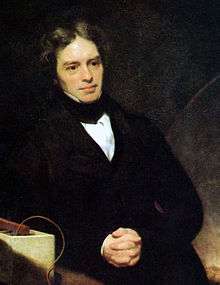Faraday's laws of electrolysis

Faraday's laws of electrolysis are quantitative relationships based on the electrochemical researches published by Michael Faraday in 1834.[1] In the same years, in Italy, Carlo Matteucci discovered the laws of electrolysis by a method totally independent Faraday's methods. The laws of electrolysis can also be called Faraday-Matteucci's laws.
Mathematical form
Faraday's laws can be summarized by
where:
- m is the mass of the substance liberated at an electrode in grams
- Q is the total electric charge passed through the substance in coulombs
- F = 96485 C mol−1 is the Faraday constant
- M is the molar mass of the substance in grams per mol
- z is the valency number of ions of the substance (electrons transferred per ion).
Note that M/z is the same as the equivalent weight of the substance altered.
For Faraday's first law, M, F, and z are constants, so that the larger the value of Q the larger m will be.
For Faraday's second law, Q, F, and z are constants, so that the larger the value of M/z (equivalent weight) the larger m will be.
In the simple case of constant-current electrolysis, leading to
and then to
where:
- n is the amount of substance ("number of moles") liberated: n = m/M
- t is the total time the constant current was applied.
In the more complicated case of a variable electric current, the total charge Q is the electric current I() integrated over time :
Here t is the total electrolysis time.[2]
See also
References
- ↑ Ehl, Rosemary Gene; Ihde, Aaron (1954). "Faraday's Electrochemical Laws and the Determination of Equivalent Weights". Journal of Chemical Education. 31 (May): 226–232. Bibcode:1954JChEd..31..226E. doi:10.1021/ed031p226.
- ↑ For a similar treatment, see Strong, F. C. (1961). "Faraday's Laws in One Equation". Journal of Chemical Education. 38 (2): 98. Bibcode:1961JChEd..38...98S. doi:10.1021/ed038p98.
Further reading
- Serway, Moses, and Moyer, Modern Physics, third edition (2005),principles of physics.